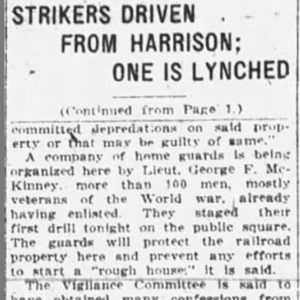calsfoundation@cals.org
Harrison Railroad Riot
aka: Missouri and North Arkansas Railroad Strike
The Harrison Railroad Riot was an outbreak of anti-union violence in the town of Harrison (Boone County), supported in part by the Ku Klux Klan (KKK), as well as the city government and local business interests. The riot was in response to a two-year strike along the Missouri and North Arkansas (M&NA) railroad and ended in the lynching of a man accused of harboring militant strikers, along with the forced exodus of most strikers north into Missouri.
The St. Louis and North Arkansas Railroad was chartered on May 17, 1899, and extended into Harrison in 1901; tracks were soon laid connecting other Ozark towns such as Leslie (Searcy County) and Heber Springs (Cleburne County) and went farther southeast to Helena (Phillips County). Reorganized as the Missouri and North Arkansas in 1906, the railroad allowed outside business interests easier access to the timber and mineral resources of the hills, “initiating a network of dependency on the line and damaging age-old patterns of subsistence living and community interdependence in the process,” according to historian Brooks R. Blevins. Work on the railroad also brought in many non-natives to the area, including some Greeks and other ethnic groups.
In December 1920, the management of the M&NA announced a cut in wages to be effective February 1, 1921. This, combined with resentment over general manager C. A. Phelan’s lush salary, led many railroad workers to walk out in February. Striking railroad workers who were members of the American Federation of Labor (AFL) headquartered themselves in Harrison, the population of which was initially sympathetic toward the strikers. However, that sympathy soon evaporated, especially as the economic hardships of the strike took hold and as striking workers engaged in violence and sabotage, such as attacking “scabs” and burning railroad bridges. On March 7, 1921, prominent citizens formed the Harrison Protective League to combat the union.
In July of that year, M&NA management announced the immediate closure of the line unless citizens would either finance the road or clear out the strikers. By May 1922, when the M&NA resumed operations, many businesses now dependent upon the railroad had closed, such as stave mills, while the strikers continued to receive benefits from out-of-state allies. The renewed operations of the railroad brought renewed sabotage, such as the burning of more bridges. In response, local “citizens’ committees” began to form across the region for the purpose of organizing people against the union. According to historian Charles C. Alexander, “There is evidence that the local Klans serve as nuclei for the committees, although the citizens’ groups unquestionably included scores of individuals who did not belong to the order.” The KKK publicly announced its support for the railroad.
The year 1923 began with over a dozen instances of sabotage, mostly bridge burnings. The M&NA soon announced the closure of the line between Eureka Springs (Carroll County) and Leslie. On January 12, two strikers were arrested for bridge-burning, and that same day, William Wenrick, editor of the Marshall Mountain Wave, published an editorial in which he called for the lynching of strikers. Three days later, approximately 1,000 armed men, many of them prominent citizens, gathered in Harrison to search for explosives and interrogate strikers.
In response to the presence of these vigilantes at his home, striking worker Ed C. Gregor fired his shotgun to disperse the group. He injured no one, but the vigilantes returned fire, wounding one of their own but later blaming it on Gregor, who was subsequently jailed. Early in the morning on January 16, 1923, a group of men in black masks kidnapped Gregor from the jail and hanged him from a railroad bridge just outside of Harrison. Other strikers were dragged from their houses and whipped. George W. O’Neal, a former member of the Harrison Protective League, was flogged for his pro-union sympathies. In other parts of the Ozarks affected by the strike, union members were similarly rounded up and beaten. A committee of twelve consisting of prominent citizens from the mob forced the resignation of Harrison’s mayor, marshal, and many councilmen—despite lacking any legal authority in the matter. The majority of the approximately 200 striking workers in Harrison and their families were rounded up and forced north across the Missouri line.
An investigation into the outbreak of violence by a joint committee of the Arkansas legislature opted not to assess blame for the riot in a final report to Governor Thomas C. McRae. Subsequent to the riot, the Klan’s popularity and numbers increased across the Ozarks, reaching an apex in the summer of 1923 but soon waning given the absence of its primary enemy—union members and their supporters.
For additional information:
Alexander, Charles C. The Ku Klux Klan in the Southwest. Norman: University of Oklahoma Press, 1995.
Barnes, Kenneth C. The Ku Klux Klan in 1920s Arkansas: How Protestant White Nationalism Came to Rule a State. Fayetteville: University of Arkansas Press, 2021.
———. “Railroad Rage.” Arkansas Democrat-Gazette, January 23, 2023, pp. 1D, 6D. Online at https://www.arkansasonline.com/news/2023/jan/23/100-years-ago-in-arkansas-1000-angry-men-crushed/ (accessed January 23, 2023).
Blevins, Brooks R. “The Strike and the Still: Anti-Radical Violence and the Ku Klux Klan in the Ozarks.” Arkansas Historical Quarterly 52 (Winter 1993): 405–425.
Brown, Lynn. “Government Operation and the Beginning of the Strike.” Boone County Historian/Oakleaves 20 (September–December): 26–36.
———. “The Strike Boils Over.” Boone County Historian/Oakleaves 21 (January–April 2021) 21–35.
Farris, John Kelly. The Harrison Riot, or The Reign of the Mob on the Missouri and North Arkansas Railroad. Wynne, AR: 1924.
Gooden, Orville Thrasher. The Missouri and North Arkansas Railroad Strike. New York: Columbia University Press, 1926.
An Industrial War: History of the Missouri and North Arkansas Railroad Strike and a Study of the Tremendous Issues Involved: An Unprecedented Result of a Common Occurrence in American Industry and its Aftermath. Harrison, AR: Bradley & Russell, 1923.
Staff of the CALS Encyclopedia of Arkansas
 Harrison Railroad Riot Article
Harrison Railroad Riot Article 




Comments
No comments on this entry yet.